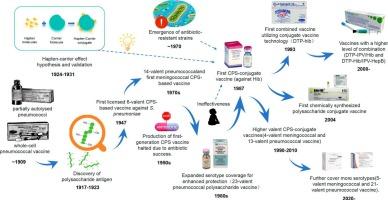Polysaccharide conjugate vaccines: From historical milestones to future strategies
IF 12.5
1区 化学
Q1 CHEMISTRY, APPLIED
引用次数: 0
Abstract
Capsular polysaccharides (CPSs) of encapsulated bacterial pathogens, such as Streptococcus pneumoniae, Haemophilus influenzae, and Neisseria meningitidis, serve as potent antigens for eliciting protective immunity against invasive infections. Polysaccharide and protein-polysaccharide conjugate vaccines have significantly reduced the global burden of diseases caused by these pathogens through direct immune protection and herd immunity. While traditional polysaccharide vaccines induce T cell-independent responses, conjugate vaccines-comprising CPSs linked to carrier proteins, drive robust T cell-dependent immunity, offering enhanced and durable protection. This review examines the evolution of polysaccharide-based vaccines, focusing on antigen design, carrier protein selection, and conjugation strategies, while addressing current challenges and future prospects. Key hurdles include the expansion of vaccine valency to broaden coverage against non-vaccine serotypes to lower the risk of serotype replacement, managing manufacturing and quality control complexities in multivalent formulations, and mitigating interference between carrier proteins and CPSs during T cell activation. Emerging strategies propose leveraging bacterial surface immunogenic proteins as novel carriers, which could streamline vaccine valency, amplify antibody-mediated protection, and circumvent existing limitations. Such innovations hold promise for advancing next-generation conjugate vaccines, optimizing efficacy while addressing the dynamic challenges of bacterial pathogenicity and vaccine development.

多糖结合疫苗:从历史里程碑到未来战略
被包裹的细菌病原体的荚膜多糖(CPSs),如肺炎链球菌、流感嗜血杆菌和脑膜炎奈瑟菌,可作为有效抗原,引发对侵袭性感染的保护性免疫。多糖和蛋白-多糖结合疫苗通过直接免疫保护和群体免疫,显著减少了由这些病原体引起的疾病的全球负担。传统的多糖疫苗诱导T细胞非依赖性应答,而结合疫苗(包含与载体蛋白连接的cps)可驱动强大的T细胞依赖性免疫,提供增强和持久的保护。本文综述了多糖疫苗的发展,重点介绍了抗原设计、载体蛋白选择和偶联策略,同时指出了当前的挑战和未来的前景。主要障碍包括扩大疫苗价以扩大针对非疫苗血清型的覆盖范围,以降低血清型替代的风险,管理多价制剂的制造和质量控制复杂性,以及减轻T细胞活化过程中载体蛋白和cps之间的干扰。新兴的策略建议利用细菌表面免疫原性蛋白作为新的载体,这可以简化疫苗的价格,增强抗体介导的保护,并绕过现有的限制。这些创新有望推进下一代结合疫苗,优化功效,同时解决细菌致病性和疫苗开发的动态挑战。
本文章由计算机程序翻译,如有差异,请以英文原文为准。
求助全文
约1分钟内获得全文
求助全文
来源期刊

Carbohydrate Polymers
化学-高分子科学
CiteScore
22.40
自引率
8.00%
发文量
1286
审稿时长
47 days
期刊介绍:
Carbohydrate Polymers stands as a prominent journal in the glycoscience field, dedicated to exploring and harnessing the potential of polysaccharides with applications spanning bioenergy, bioplastics, biomaterials, biorefining, chemistry, drug delivery, food, health, nanotechnology, packaging, paper, pharmaceuticals, medicine, oil recovery, textiles, tissue engineering, wood, and various aspects of glycoscience.
The journal emphasizes the central role of well-characterized carbohydrate polymers, highlighting their significance as the primary focus rather than a peripheral topic. Each paper must prominently feature at least one named carbohydrate polymer, evident in both citation and title, with a commitment to innovative research that advances scientific knowledge.
 求助内容:
求助内容: 应助结果提醒方式:
应助结果提醒方式:


